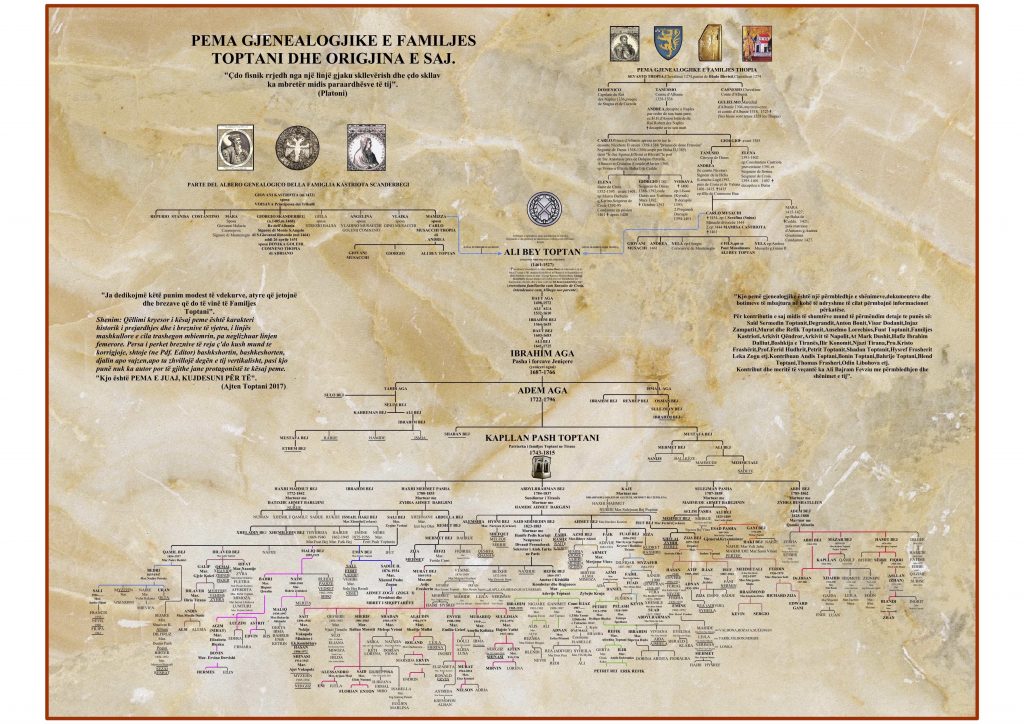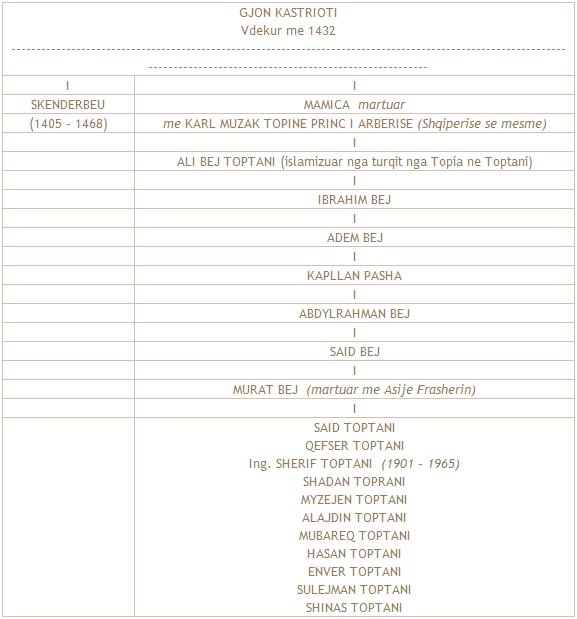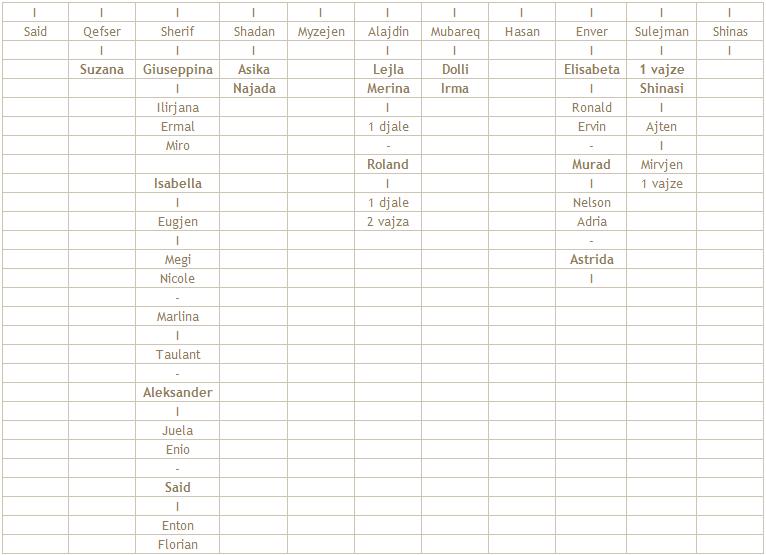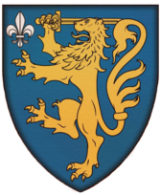Toptani Family Tree
The following is an updated version of the Toptani Family Tree

The following is an excerpt from the “Albanian Newspaper”, dated November 9, 2002

This Family Tree indicates that the Toptani sons are an 8th generation of Mamica Kastrioti and Karl Topia.
Asije, Murat’s wife was the daughter of Sherif Frasheri. When her father died, little Asija was adopted by her uncle, the great Albanian poet Naim Frasheri. She was raised and educated by him. She took knowledge in pharmacy and played the piano. She married Murat Bey Toptani. Naim and Murat had the same ideals for their Albanian motherland.
As the tree shows, the generation still continues to date from the 11 children of Murat and Asije.
Murat Toptani's Family Tree

Genealogical Tree of Skanderbeg's Family
From “Gazeta Shqiptare” (“Albanian Gazette”), dated: November 9, 2002, written by Lec Shillaku
Fisniku and Gjergj Kastriot-Skënderbej’s descendants send us greetings. They have included the Kastrioti Family genealogical tree to celebrate our magazine’s jubilee. Fisniku honorably maintains the name Giorgio Castriota Scanderbeg, like his great grandfather, our national hero. He lives with his family in the outskirts of Napoli. Through the centuries, we’ve only had limited knowledge about the Kastrioti family and succeeding generations, therefore we have tried to find verification directly from the Kastrioti family itself, with whom we have been in contact since the inauguration of Skënderbej Square in Paris. As historically recorded, after the death of Skënderbej and the Ottoman occupation of Albania, Skanderbeg’s family immigrated and settled in southern Italy. This was the land that the king of Napoli, Ferdinand of Arragona, donated to the family in recognition of the military contribution Skanderbeg gave him when he arrived in Italy, in August of 1461, to fight against the Prince of Taranto Giacomo Piccinino and his allies. They had surrounded the King in Trahi, and they supported the french D’Agnious’ to reign over Napoleon’s Kingdom.
Skanderbeg’s descendants failed in their efforts to rid the country of the Ottoman occupation, despite their pleading to Venedic for their help and urging their people to up-rise against the Ottomans. They eventually settled for good in Italy, though they never ceased remembering their Arbër country. The genealogical tree of the Kastriots shows that, while in Italy, they held many and various noble titles in the regions, cities and villages they owned. They married women of aristocratic descent, who brought real estate, dowery, and more into the marriage according to the tradition of that time, which strengthened and established their position. Marriages resulted in many sons and daughters born to the Kastriots in Italy, which ensured the the Kastriot’s name to last to this day.
The direct descendants of the Kastrioti family in this genealogical tree are considered, according to our tradition, by male descendants. Therefore, some of the family tree branches died out due to lack of male descendants.
A branch in the genealogical tree of the Kastriots is the Topia (Toptani after islamization) family. In 1445 Skanderbeg’s sister, Mamica, was married to Karl Muzhak Topia and had three sons: Gjon, Gjergj and Ali Bey Toptani (islamized name). These genealogical notes indicate that the current Toptani family is descended from the first Ali Bey Toptani, the son of Gjergj Kastrioti Skënderbeu’s sister. Unfortunately, the genealogical tree of the Toptanis is incomplete and due to lack of contact with with the family for many centuries, therefore many records are missing. As the family tree indicates, the Toptani family was well known for centuries and derives directly from the Karl Topia I, Prince of Arbëria (Central Albania), who requested military assistance from the Turkish army in Macedonia in order to fend off threats from Balsha II and the Venedics. In 1935, the Turkish army, under the command of Hajredin Pasha, defeated the army of Balsha south of Lushnja, where Blasha II was killed. This was the first time the Turks entered Albania and it was evident that this would result in severe consequences, considering Turks had begun conquering the whole of the Balkans. Because of the century long Ottoman occupation of Albania, and the long absence of the Kastriot descendants, Kastriots did not have an opportunity to reestablish their dynasty in Albania. A stranger was preferred instead, Prince Vidi, who left a phantom dynasty upon his death under Skënder Wied. The current Kastriots, especially Ferdinant Kastrioti (15.1.1893 – 18.7.1978), were interested in Albanian memorials and events. In April of 1968, the first representative of Ferdinant’s family, as well as other family members were present at Kastriot memorial services of 500th anniversary of Skanderbeg’s death in Rome. His descendants Filip (died in 1984) and Gjergj (1928) represent the Kastriots’ family. Ferdinand also has two daughters; Maria (4.2.1958) and Maria-Luisa (30.4.1963). Filip has continued the family line and name with two daughters and Gjergj, his only son (2.8.1958).
Below is the telegram Filip addressed to Mr. Chirac in Paris at the inauguration of Skanderbeg’s Square in Tirane (not included in this website). Gjergj has contacted us regarding the tradition of the Kastrioti Family. According to the genealogical tree of the Kastriots, the most reknowned names of the family, Gjon (John) and Gjergj (George), have been recorded for every generation. Thanks also to Aragons for the names Ferdinant Alfons. As historical names, we have Pirro and Akil. Regarding Pirro, Skënderbeu bragged to Count Picinnino that he and his fellow Albanians came from the same race and have the same blood. Prominent women names including Donika, Maria, and Mara have been recorded.
Paris, November, 1986

